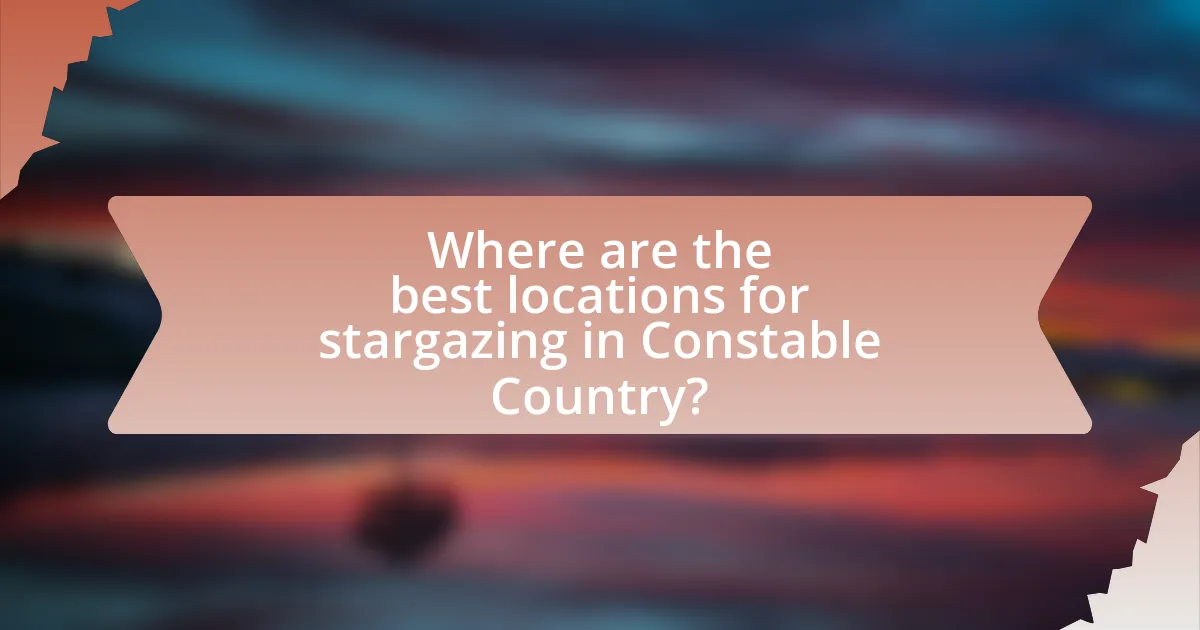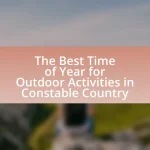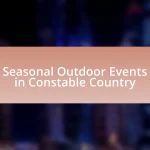Stargazing in Constable Country refers to the activity of observing celestial bodies in the night sky within Suffolk, England’s scenic Dedham Vale Area of Outstanding Natural Beauty. The region is characterized by low light pollution, diverse landscapes, and clear skies, making it ideal for both amateur and experienced astronomers. Key topics covered include the best times and locations for stargazing, recommended equipment, and tips for enhancing the experience, such as considering lunar phases and seasonal changes. Additionally, the article discusses the impact of light pollution and offers practical advice for planning successful stargazing outings in this picturesque area.

What is Stargazing in Constable Country?
Stargazing in Constable Country refers to the activity of observing celestial bodies in the night sky within the scenic landscape of Constable Country, an area in Suffolk, England, known for its natural beauty and historical significance. This region offers dark skies, minimal light pollution, and picturesque settings, making it ideal for viewing stars, planets, and constellations. The area’s designation as an Area of Outstanding Natural Beauty enhances its appeal for stargazers, as it provides a tranquil environment conducive to astronomical observation.
Why is Constable Country a popular destination for stargazing?
Constable Country is a popular destination for stargazing due to its low light pollution and expansive rural landscapes. The area, located in the Dedham Vale AONB, offers clear skies that enhance visibility of celestial bodies. Additionally, its designation as an Area of Outstanding Natural Beauty ensures that development is limited, preserving the natural environment ideal for observing stars and constellations. The combination of these factors makes Constable Country an attractive location for both amateur and experienced stargazers.
What unique features of Constable Country enhance the stargazing experience?
Constable Country enhances the stargazing experience through its low light pollution, diverse landscapes, and clear skies. The area is designated as an Area of Outstanding Natural Beauty, which helps to minimize artificial light, allowing for clearer views of celestial bodies. Additionally, the varied topography, including hills and valleys, provides unique vantage points for observing the night sky. The region’s commitment to preserving natural environments further contributes to its suitability for stargazing, making it an ideal location for both amateur and experienced astronomers.
How does the natural landscape of Constable Country contribute to stargazing?
The natural landscape of Constable Country enhances stargazing by providing dark skies, minimal light pollution, and scenic backdrops. The area’s rural setting, characterized by open fields and low population density, allows for clearer visibility of celestial bodies. Additionally, the presence of natural features such as hills and valleys can create vantage points that further improve the stargazing experience. These conditions are essential for observing stars, planets, and other astronomical phenomena without interference from artificial lights.
What are the best times for stargazing in Constable Country?
The best times for stargazing in Constable Country are during the new moon phase and on clear nights with minimal light pollution. The new moon occurs when the moon is not visible in the night sky, providing darker conditions that enhance visibility of celestial objects. Additionally, late spring to early autumn offers optimal weather conditions, as these months typically feature clearer skies and milder temperatures, making stargazing more enjoyable.
How do seasonal changes affect visibility of celestial events?
Seasonal changes significantly affect the visibility of celestial events due to variations in atmospheric conditions, daylight hours, and the position of celestial bodies. For instance, during winter months, longer nights and clearer skies often enhance visibility for events like meteor showers and planetary alignments. Conversely, summer months may present challenges such as increased humidity and shorter nights, which can obscure celestial phenomena. Additionally, the tilt of the Earth’s axis alters the angle of view for constellations and planets, making certain celestial events more prominent in specific seasons. For example, the Perseid meteor shower is best viewed in August, while the Geminids peak in December, demonstrating how seasonal timing directly influences visibility.
What lunar phases are ideal for stargazing?
The ideal lunar phases for stargazing are the new moon and the waxing crescent. During the new moon, the sky is darkest, allowing for optimal visibility of celestial objects without interference from moonlight. The waxing crescent phase also provides a relatively low level of moonlight, making it suitable for observing stars and deep-sky objects. Research indicates that light pollution from the moon can significantly hinder stargazing, with the new moon phase being the most favorable for clear views of the night sky.
What equipment is recommended for stargazing in Constable Country?
For stargazing in Constable Country, a telescope or binoculars are highly recommended for enhanced visibility of celestial objects. Telescopes allow for detailed observation of planets and deep-sky objects, while binoculars provide a portable option for casual stargazing. Additionally, a star map or stargazing app can help identify constellations and celestial events, enhancing the overall experience. These tools are essential for making the most of the dark skies in Constable Country, which is known for its low light pollution, making it an ideal location for astronomy enthusiasts.
What types of telescopes are best suited for beginners?
Refractor and reflector telescopes are best suited for beginners. Refractor telescopes use lenses to gather light and are known for their ease of use and low maintenance, making them ideal for novice astronomers. Reflector telescopes utilize mirrors and offer larger apertures at a lower cost, allowing beginners to observe faint celestial objects effectively. Both types provide a good balance of performance and affordability, which is essential for those just starting in astronomy.
How can binoculars enhance the stargazing experience?
Binoculars enhance the stargazing experience by providing a closer and clearer view of celestial objects. They allow stargazers to observe details such as the craters on the Moon, the rings of Saturn, and star clusters that are not visible to the naked eye. The magnification offered by binoculars, typically ranging from 7x to 15x, significantly improves visibility and detail, making it easier to appreciate the vastness and beauty of the night sky. Additionally, binoculars are portable and user-friendly, making them accessible for both novice and experienced stargazers, thus enriching the overall experience of observing astronomical phenomena.

Where are the best locations for stargazing in Constable Country?
The best locations for stargazing in Constable Country include Dedham Vale, Flatford, and the area around the River Stour. Dedham Vale, designated as an Area of Outstanding Natural Beauty, offers minimal light pollution, enhancing visibility of celestial bodies. Flatford, known for its picturesque landscapes, provides open skies ideal for observing stars. The River Stour’s banks also present a tranquil setting, free from urban distractions, making it a prime spot for stargazing. These locations are recognized for their natural beauty and low light interference, which are essential for optimal stargazing experiences.
What specific sites in Constable Country are recommended for stargazing?
The specific sites in Constable Country recommended for stargazing include Dedham Vale, Flatford, and the area around the River Stour. Dedham Vale offers expansive views with minimal light pollution, making it ideal for observing celestial events. Flatford, known for its picturesque landscapes, also provides a clear sky for stargazing. The River Stour area, with its open fields and rural setting, enhances visibility of stars and constellations. These locations are recognized for their natural beauty and favorable conditions for astronomy enthusiasts.
How does each location differ in terms of visibility and accessibility?
Each location in Constable Country varies significantly in visibility and accessibility. For instance, locations like Flatford Mill offer clear views of the night sky due to minimal light pollution, making it ideal for stargazing. In contrast, areas closer to towns, such as East Bergholt, experience higher light pollution, which diminishes visibility of celestial objects. Accessibility also differs; Flatford Mill is easily reachable by car and has nearby parking, while more remote spots may require longer walks or less developed paths, impacting ease of access. These factors collectively influence the overall stargazing experience in Constable Country.
What amenities are available at these stargazing locations?
Stargazing locations in Constable Country typically offer amenities such as designated viewing areas, parking facilities, restrooms, and sometimes picnic areas. These amenities enhance the stargazing experience by providing comfort and convenience for visitors. For instance, locations like Dedham Vale and Flatford offer accessible parking and nearby facilities, making it easier for families and groups to enjoy the night sky.
How can local parks and nature reserves enhance the stargazing experience?
Local parks and nature reserves enhance the stargazing experience by providing dark skies, minimal light pollution, and open spaces that allow for unobstructed views of celestial events. These areas often have designated stargazing spots, which are strategically chosen to maximize visibility and comfort. For instance, parks like Constable Country are located away from urban areas, significantly reducing artificial light interference, which is crucial for observing faint stars and celestial phenomena. Additionally, nature reserves may offer educational programs and guided stargazing events, enriching the experience with expert knowledge about constellations and astronomical events.
What are the benefits of stargazing in protected areas?
Stargazing in protected areas offers numerous benefits, including enhanced visibility of celestial bodies due to reduced light pollution. Protected areas, such as national parks, maintain dark skies that allow for clearer views of stars, planets, and other astronomical phenomena. Research indicates that areas like the Grand Canyon National Park have been recognized for their exceptional night sky quality, attracting both amateur and professional astronomers. Additionally, stargazing in these locations fosters a deeper connection to nature and promotes mental well-being by providing a serene environment for reflection and relaxation.
Which parks in Constable Country are particularly noted for their dark skies?
The parks in Constable Country particularly noted for their dark skies are Dedham Vale and the Stour Valley. These areas are recognized for their low light pollution, making them ideal for stargazing. The Dedham Vale Area of Outstanding Natural Beauty (AONB) has been highlighted for its efforts in preserving dark skies, allowing for clearer views of celestial events.

What tips can enhance the stargazing experience in Constable Country?
To enhance the stargazing experience in Constable Country, choose locations away from artificial light, such as Dedham Vale or Flatford, which are known for their dark skies. These areas provide optimal visibility for celestial observations. Additionally, visiting during a new moon phase maximizes darkness, allowing for clearer views of stars and constellations. Using a star map or stargazing app can help identify celestial objects, making the experience more engaging. Finally, bringing a telescope or binoculars can significantly improve the visibility of planets and deep-sky objects, enriching the overall stargazing experience.
How can one prepare for a successful stargazing outing?
To prepare for a successful stargazing outing, one should choose a location with minimal light pollution, such as remote areas in Constable Country. Research indicates that light pollution significantly hinders visibility of celestial objects, so selecting a dark site enhances the experience. Additionally, checking weather conditions is crucial; clear skies are essential for optimal stargazing. According to the Clear Sky Chart, a reliable resource for weather forecasts specific to astronomy, clear nights provide the best visibility. Bringing necessary equipment, such as a telescope or binoculars, and downloading stargazing apps can further enhance the experience by helping identify constellations and celestial events.
What clothing and supplies should be brought for comfort and convenience?
For comfort and convenience during stargazing in Constable Country, it is essential to bring warm clothing, a blanket or sleeping bag, and a comfortable chair. Warm clothing, including layers, helps regulate body temperature in cooler night air, while a blanket or sleeping bag provides insulation against the ground and additional warmth. A comfortable chair allows for prolonged sitting without discomfort, enhancing the overall experience. These items are crucial for maintaining comfort during extended periods of stargazing, especially in open areas where temperatures can drop significantly at night.
How can one plan for weather conditions when stargazing?
To plan for weather conditions when stargazing, one should check local weather forecasts for cloud cover, precipitation, and wind conditions prior to the event. Accurate forecasts can be obtained from reliable sources such as the National Weather Service or weather apps that provide hourly updates. For optimal stargazing, clear skies with minimal light pollution are essential, as they enhance visibility of celestial objects. Historical data indicates that certain months or seasons may offer more favorable weather patterns for stargazing in specific locations, such as Constable Country, where clear nights are more common.
What are some common mistakes to avoid while stargazing?
Common mistakes to avoid while stargazing include not checking the weather conditions, which can lead to disappointment if clouds obstruct visibility. Additionally, failing to allow your eyes to adjust to the darkness can hinder your ability to see faint stars; it typically takes about 20-30 minutes for full dark adaptation. Another mistake is using bright lights, such as phone screens, which can ruin night vision; using red light instead is recommended. Lastly, not having a plan or a star map can result in confusion and missed celestial events, as knowing what to look for enhances the experience.
How can light pollution affect the stargazing experience?
Light pollution significantly diminishes the stargazing experience by obscuring celestial objects and reducing visibility of stars. This phenomenon occurs when artificial light from urban areas scatters in the atmosphere, creating a bright sky that washes out fainter stars and astronomical features. Studies indicate that over 80% of the world’s population lives under light-polluted skies, making it increasingly difficult for stargazers to observe constellations, planets, and other celestial phenomena. Consequently, effective stargazing requires locations with minimal light pollution, such as remote areas away from city lights, to enhance visibility and enjoyment of the night sky.
What should be considered regarding safety and navigation at night?
When stargazing at night, it is crucial to consider visibility, navigation tools, and personal safety. Visibility can be affected by light pollution, so choosing a dark location away from city lights enhances the stargazing experience. Navigation tools such as star charts or mobile apps help identify constellations and celestial objects, ensuring accurate orientation in the night sky. Personal safety involves being aware of the terrain, potential wildlife, and weather conditions, as well as informing someone about your location and expected return time. These considerations are essential for a safe and enjoyable stargazing experience.
What are the best practices for observing celestial events in Constable Country?
The best practices for observing celestial events in Constable Country include selecting dark locations away from artificial light, using a star map or app for navigation, and timing observations according to celestial event schedules. Dark locations, such as Dedham Vale or Flatford, minimize light pollution, enhancing visibility of celestial bodies. Utilizing star maps or astronomy apps helps identify constellations and planets, making the experience more engaging. Additionally, checking the timing of events like meteor showers or eclipses ensures optimal viewing conditions, as certain events are best observed at specific times of the night or year.
How can one find and track constellations and planets effectively?
To find and track constellations and planets effectively, one should utilize star charts or mobile apps designed for stargazing, which provide real-time information about celestial objects. These tools allow users to identify constellations and planets based on their location and the time of year. For instance, apps like SkySafari and Stellarium use augmented reality to overlay constellations and planets onto the night sky, making it easier to locate them. Additionally, observing during clear nights away from light pollution enhances visibility, as confirmed by studies indicating that darker skies significantly improve stargazing experiences.
What resources are available for learning about upcoming celestial events?
Astronomy websites and mobile applications are essential resources for learning about upcoming celestial events. Websites like NASA’s official site, Time and Date, and the American Astronomical Society provide detailed calendars and articles on astronomical events such as meteor showers, eclipses, and planetary alignments. Additionally, mobile apps like SkySafari and Star Walk offer real-time notifications and interactive sky maps, enhancing the stargazing experience. These resources are widely recognized for their accuracy and user-friendly interfaces, making them reliable tools for both amateur and experienced astronomers.


